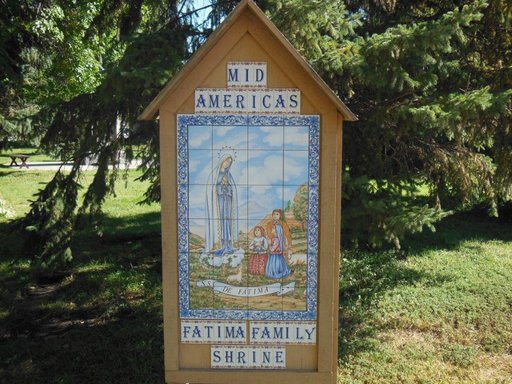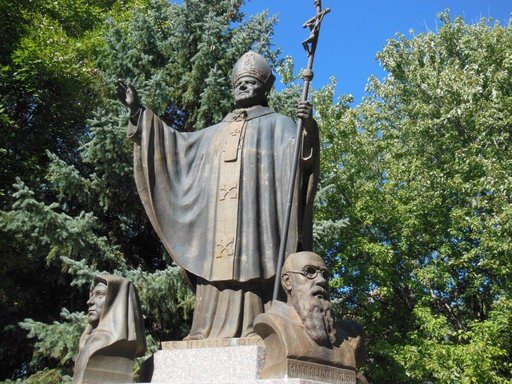Finding Fatima in the Dakotas
Family Shrine Offers Prayerful Solace in South Dakota

Not all American Catholics have the time and money to make a pilgrimage to Fatima, Portugal, where Mary appeared to three shepherd children, Lúcia Santos and her cousins, Jacinta and Francisco Morta.
However, they can experience Fatima at the Fatima Family Shrine in Alexandria, S.D., a beautiful sanctuary few have heard of just off of I-90.
A popular destination for family vacations is the Black Hills. Catholics driving west to experience the Badlands, Mount Rushmore and other sights should devote a couple of hours in Alexandria.
Located about an hour west of Sioux Falls, the largest city in the Dakotas, and 15 minutes east of Mitchell, home to the tourist trap known as “The World’s Only Corn Palace,” Alexandria looks like any other small town in the Great Plains. Anyone who’s grown up in the Midwest knows what it looks like: The tallest building is the grain elevator, and the town’s life focuses on Main Street.
However, Alexandria is unique. In the middle of town is a Marian shrine that was dedicated by Bishop Alberto Amaral of Leiria-Fátima on Sept. 27, 1987 — as 1987 was proclaimed a Marian year by Pope St. John Paul II — from the initiative of Father Robert Fox (1928-2009).

Father Fox first thought of building the shrine two years prior. This priest — who organized Marian congresses in South Dakota, edited the Immaculate Heart Messenger, directed the World Apostolate of Fatima and frequently appeared on EWTN — was committed to spreading the message Mary imparted in Fatima: that she will save the world from disaster if we pray the Rosary and live according to Catholic values. Father Fox funded the shrine’s building from the sales of his books and some donations.
Prayerful Place
At the base of the Fatima Family Shrine are soil and rock from the exact place next to the oak tree where Mary appeared to the three children in Portugal. The shrine features four chapels made of South Dakota granite, each with Portuguese marble statues of the Holy Family, Jesus and the angel as he appeared to the children. Fifteen golden stars are found in the backdrops of stained glass, representing mysteries of the Rosary.
Next to the shrine, there is also the so-called Penitential Path. At its beginning, there is a 12-foot granite cross that was erected in the Jubilee Year 2000 and blessed by Bishop Robert Carlson, then-bishop of Sioux Falls (presently, he is archbishop of St. Louis).
The most inspiring part of the Penitential Path is the Pope and Martyrs’ Shrine. It is topped by a majestic marble sculpture of Pope St. John Paul II. Although he survived two assassination attempts, this pope was a true symbol of the martyred Church of the past century, himself coming from the persecuted Polish Church and frequently defending persecuted Catholics. He is surrounded by busts of four outstanding Catholics who gave their lives in the name of Christian virtues: St. Maximilian Kolbe, a Polish Franciscan who volunteered to give his life in a starvation bunker for another inmate at Auschwitz; St. Gianna Beretta Molla, an Italian doctor who gave up her life to save her unborn daughter’s life in the 1960s, during the “sexual revolution”; Blessed Miguel Pro, a courageous Mexican Jesuit arrested and shot for evangelizing his flock by Mexico’s anti-clerical government in the 1920s; and St. Teresa Benedicta of the Cross, born Edith Stein, a Jewish philosopher who converted to Catholicism and was killed in Auschwitz after the Nazis decided to exterminate Jewish-Catholic converts as a vendetta against the Dutch bishops’ protest against the genocide of the Jews.

Next, there is the Pro-Life Shrine. It features Our Lady of Guadalupe, patroness of the Americas. When Our Lady appeared to Indian peasant Juan Diego in Mexico in 1531, she asked that a Marian shrine be built in the place of a temple dedicated to an Aztec goddess, where human sacrifices were made. Just as Mary asked the Mexican people to replace a pagan civilization with concern for human dignity almost 500 years ago, she again asks us to reject what Pope Francis has called the “throwaway culture” of Planned Parenthood and anti-family legislation with what Blessed Paul VI called “a civilization of love.”
At the conclusion of the Penitential Path is a statue of the Angel of the Family, consecrated by Archbishop Tadesuz Kondrusiewicz (then the apostolic administrator for European Russia; today he leads the persecuted Belarusian Church as archbishop of Minsk), as well as Stations of the Cross.
The shrine is located next to the Catholic parish of St. Mary of Mercy, a lovely church made of South Dakota granite. Inside, one can find a replica of the statue of Mary found in Fatima.
When Father Fox organized Marian Congresses in Alexandria, Fatima candlelight processions left from the church. Since then, they have ceased, although the current pastor of St. Mary’s, Father Dana Christensen, promises they will come back in 2017 for the centenary of the Fatima apparitions.
Across the street from the church, there is a convent where cloistered Discalced Carmelite nuns work and pray. There also is a bookstore where visitors can choose from the standard Ignatius Press inventory available at most American Catholic bookstores, holy cards and the 50 books that Father Robert Fox wrote, the profits from which helped fund the shrine.
Having read about this beautiful Marian shrine in America’s Heartland, you might logically assume that this place is inundated with pilgrims from across the Midwest. Unfortunately, this is not the case. The Fatima Family Shrine receives no publicity apart from two billboards on I-90. It doesn’t even have its own website or Facebook page. This is unfortunate, given the intense religious inspiration visiting here can bring. Furthermore, the shrine is maintained mostly thanks to freewill donations.
So, the next time you’re planning a family vacation in the Black Hills, be sure to stop by the Fatima Family Shrine. Short of traveling to Fatima or other great European Marian shrines, you won’t have an experience like this anywhere else.
Register correspondent Filip Mazurczak is from South Dakota.
- Keywords:
- fatima
- our lady of fatima
- travel















